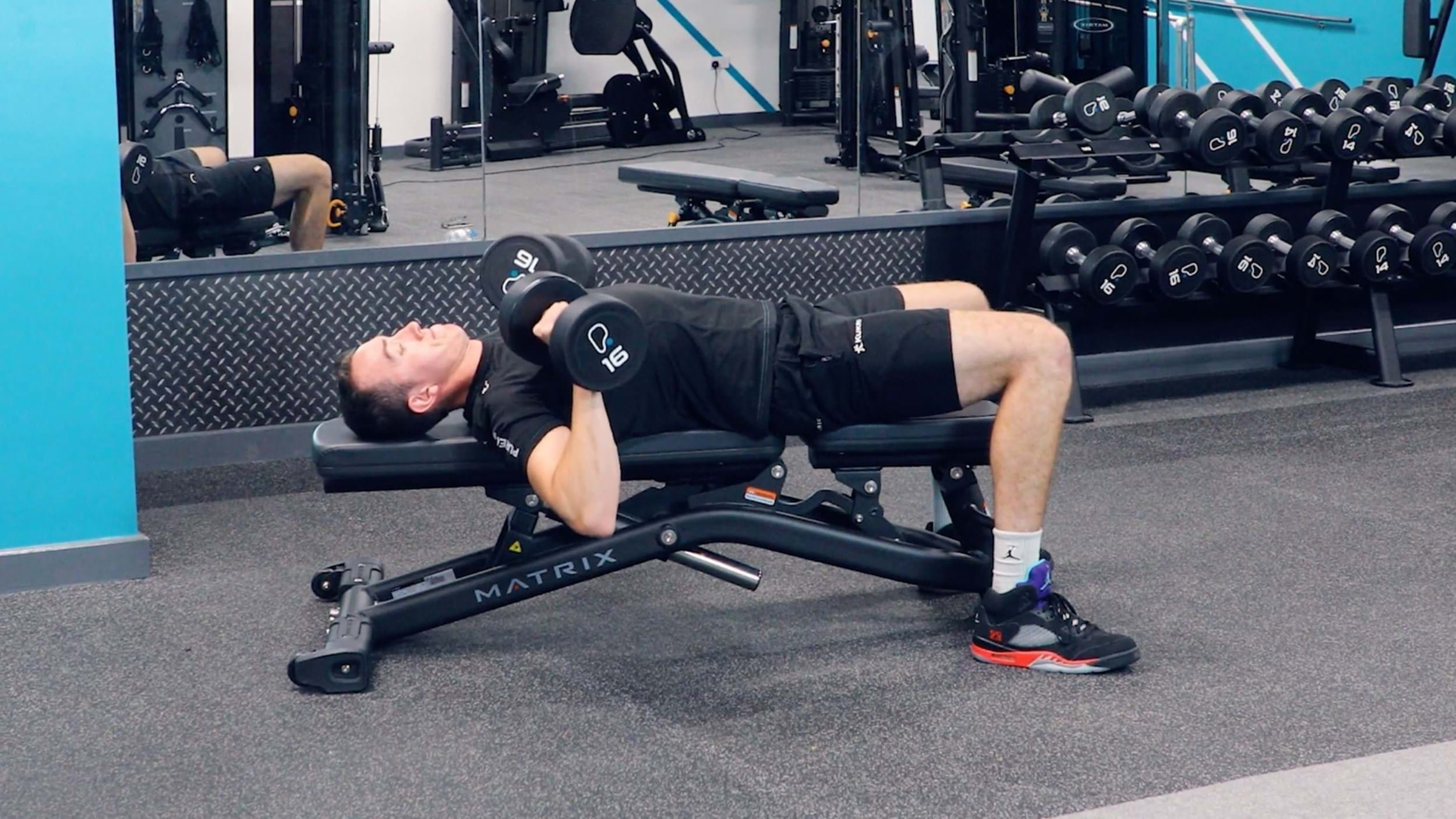Dumbbell Bench Press
What Is A Dumbbell Bench Press?

The dumbbell bench press is a version of the bench press that uses dumbbells instead of a barbell. Using two dumbbells and a bench, this exercise challenges the performer to lower both dumbbells to their chest before extending the arms to press them back up again. This bench press variation has an increased range of motion as the dumbbells can surpass the chest slightly.
Primarily targeting the chest muscles, the dumbbell press will activate the pectorals, triceps, and deltoids. The dumbbell bench press requires greater balance and stability so greater core engagement is needed.
The dumbbell bench press is great for beginners who want to build strength and stability before progressing to the barbell bench press, but equally valuable for intermediate and advanced lifters as a way to build unilateral strength and improve stability.
The dumbbell press can also be varied to regress the movement or add different challenges. For example, the neutral grip dumbbell press (palms facing each other) reduces involvement from the deltoids and places less stress on the shoulder joint, making it a suitable option for anyone wanting to focus on the chest and triceps while reducing injury risk, and the dumbbell floor press has a reduced range of movement which makes it suitable for beginners.
The dumbbell floor press has a reduced range of motion, making it a good option for beginners or those recovering from injury, while the alternating dumbbell bench press works shoulder and core stability more.
Check out some other chest press variations: incline dumbbell press, close grip bench press, decline dumbbell bench press, single arm chest press, seated chest press
Commonly Asked Questions On Dumbbell Bench Press
There is an increased demand for stability for the bench press, and most people will be unable to lift as much weight with the dumbbell press as they would the barbell bench press.
Some people may however find the dumbbell press more comfortable due to the more flexible positioning of the dumbbell set up.
Compound exercises are exercises which use multiple joints, while isolation exercises refer to just one joint being used. The dumbbell bench press is a compound exercise because it uses multiple joints – the shoulders and the elbows. Compound exercises are often considered to be of greater benefit than isolation moves and should make up the majority of an individual’s training programme.
The dumbbell bench press helps to build strength and stability in the pectorals, deltoids, and triceps. It is an effective upper body movement that makes a suitable addition to your workout routine if you want to build strength or muscle mass.
Dumbbell Bench Press Tips
The setup of the dumbbell bench press is important to ensure that the correct muscles are being targeted and to reduce injury risks. Sometimes performers may feel pain in the shoulders which often occurs due to increased strain on the deltoids, which is due to form issues. While the shoulders are involved in the dumbbell bench press, most of the weight should be lifted by the pectorals.
To avoid excess shoulder strain, pin the shoulder blades to the bench creating a slight arch in the back and ensure to tuck the elbows as you press rather than allowing them to flare outwards. Think about creating an arrow shape with your arms and your head when in the bottom of the movement to ensure less strain on the shoulders.
How To Do A Dumbbell Bench Press
Gripping two dumbbells, sit on a bench before slowly lying down and extending your arms so that the dumbbells are above you, palms facing towards your feet.
Retract your shoulder blades by pulling your shoulder blades into the bench and pressing through your feet. This should create an arch in your lower back, which helps to protect the shoulder joint.
As you lower the dumbbells, keep the elbows tucked to prevent the elbows from flaring.
Lower the dumbbells in line with your mid chest, making sure to lower the dumbbells until they are either side of the chest.
Return to the starting position by pushing through your arms, chest and feet as you lift the dumbbells back up in an arc direction until your arms are extended.
How To Do A Neutral Grip Dumbbell Press
Gripping two dumbbells, sit on a bench before slowly lying down and extending your arms so that the dumbbells are above you. Rotate your wrists so that your palms face each other.
Retract your shoulder blades by pulling your shoulder blades into the bench and pressing through your feet. This should create an arch in your lower back, which helps to protect the shoulder joint.
Lower the dumbbells in line with your mid chest, making sure to lower the dumbbells until they are either side of the chest. As you lower the dumbbells, keep the elbows tucked to your sides to prevent the elbows from flaring.
Return to the starting position by pushing through your arms, chest and feet as you lift the dumbbells back up in an arc direction until your arms are extended.
How To Do A Dumbbell Floor Press
Grip two dumbbells then lie down on a mat, feet flat on the floor with knees facing the ceiling. Extend your arms so that the dumbbells are above you then pull your shoulder blades back and down.
Lower the dumbbells in line with your mid chest, stopping when the back of your arms touch the floor. As you lower the dumbbells, keep the elbows tucked to prevent the elbows from flaring.
Return to the starting position by pushing through your arms, chest and feet as you lift the dumbbells back up in an arc direction until your arms are extended.
If you’re not sure if any of the above exercises are suitable for you, please consult your doctor before you start it. Need guidance on how to perform the exercise? Ask a personal trainer at your gym.